Combining lossless and lossy compression techniques can lead to significant performance gains by optimizing file sizes while balancing quality and efficiency. Lossless methods preserve all original data, making them ideal for applications requiring high fidelity, while lossy techniques effectively reduce sizes for bandwidth-sensitive scenarios. Understanding the strengths of each approach allows for tailored solutions that enhance data transfer, storage, and processing efficiency.
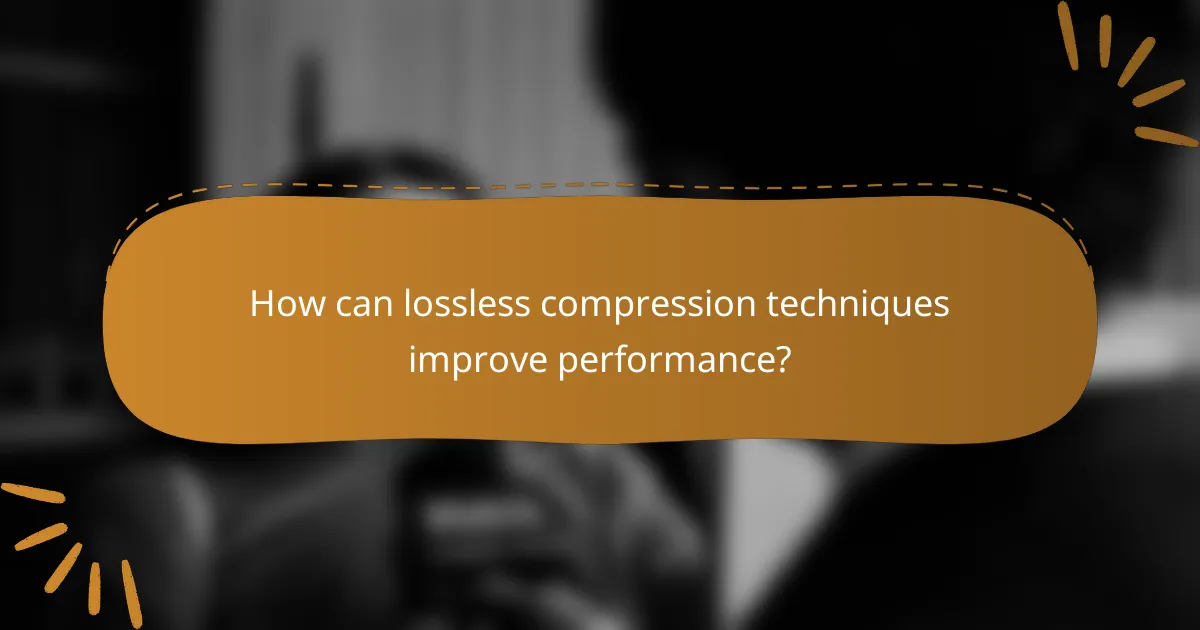
How can lossless compression techniques improve performance?
Lossless compression techniques enhance performance by reducing file sizes without sacrificing quality. This leads to faster data transfer, lower storage costs, and improved efficiency in processing and retrieval.
Reduces file size without quality loss
Lossless compression algorithms, such as ZIP or PNG, minimize file sizes while preserving the original data integrity. This is particularly useful for text documents and images where quality is paramount. For instance, a lossless image might reduce file size by 20-50% compared to its uncompressed counterpart.
When implementing lossless compression, consider the type of data being compressed. Text files typically compress better than already compressed formats like MP3 or JPEG. Always evaluate the trade-off between compression ratio and processing time to ensure optimal performance.
Enhances data integrity
Lossless compression maintains data integrity by ensuring that the original information can be perfectly reconstructed. This is crucial for applications where accuracy is essential, such as in legal documents or medical imaging. Using lossless formats helps avoid any risk of data corruption during compression.
To maximize data integrity, choose well-established lossless algorithms that are widely supported and tested. Regularly verify the integrity of compressed files, especially when transferring them across different systems or networks, to prevent potential issues.
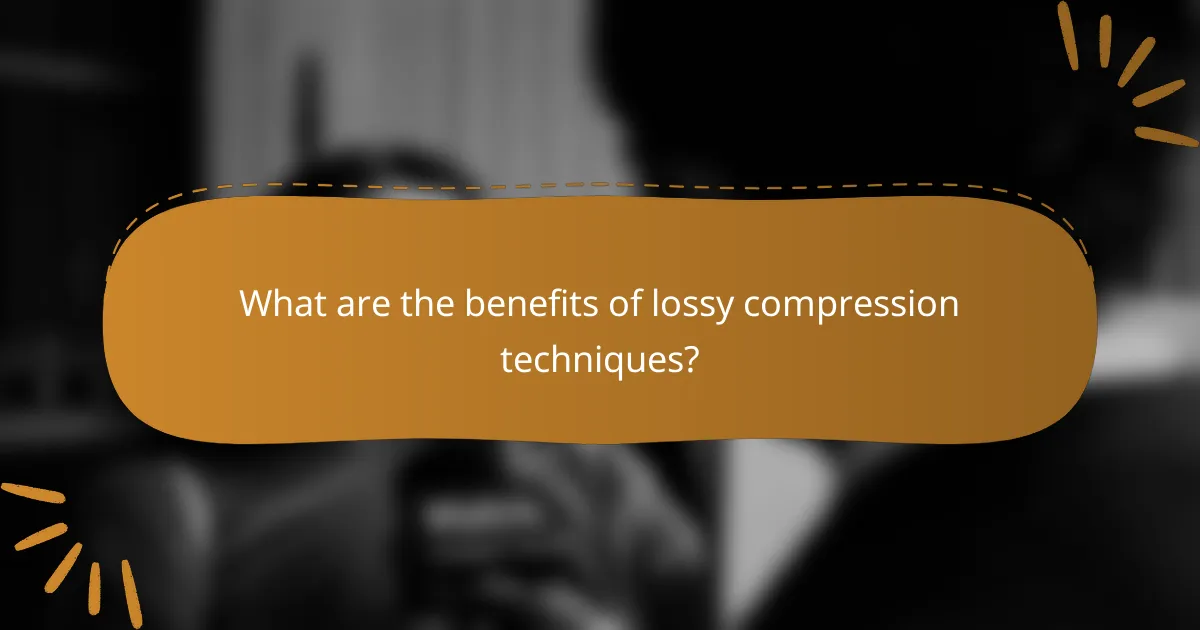
What are the benefits of lossy compression techniques?
Lossy compression techniques provide significant advantages, primarily through reducing file sizes while maintaining acceptable quality. This is particularly beneficial for applications like streaming media and web content, where bandwidth and storage are critical considerations.
Significantly smaller file sizes
One of the main benefits of lossy compression is the ability to achieve significantly smaller file sizes, often reducing original data by 50% to 90%. This reduction is accomplished by removing less critical data, which is less noticeable to users. For example, JPEG images and MP3 audio files utilize lossy compression to minimize storage requirements while still delivering satisfactory quality.
When choosing a lossy compression method, consider the trade-off between quality and size. Higher compression ratios lead to smaller files but may result in noticeable quality loss. Aim for a balance that meets your needs, especially for applications where quality is paramount.
Faster load times for web content
Faster load times are a direct benefit of using lossy compression techniques, making web content more accessible and user-friendly. Smaller file sizes mean that data can be transmitted more quickly over the internet, which is crucial for maintaining user engagement. For instance, a well-compressed image can load in a fraction of a second, enhancing the overall user experience.
To optimize load times, consider implementing lossy compression for images, videos, and audio files on your website. Tools like image optimizers and audio compressors can help achieve the desired balance between quality and performance. Avoid overly aggressive compression that may lead to poor user experiences, as this can drive visitors away from your site.

How do lossless and lossy compression compare?
Lossless and lossy compression are two distinct techniques used to reduce file sizes. Lossless compression retains all original data, while lossy compression sacrifices some data for greater size reduction, making it essential to choose the right method based on specific needs.
Quality vs. file size trade-offs
The primary trade-off between quality and file size in compression techniques is evident in lossy formats, which can significantly reduce file sizes at the cost of audio or image fidelity. For example, JPEG images can be compressed to a fraction of their original size, but excessive compression may lead to visible artifacts.
In contrast, lossless formats like PNG or FLAC maintain the original quality but typically result in larger files. Users should consider their needs: if high fidelity is crucial, lossless is preferable; if storage space is limited, lossy may be acceptable.
Use cases for each technique
Lossless compression is ideal for applications where data integrity is paramount, such as in medical imaging, technical drawings, or archival storage. Formats like ZIP or FLAC are commonly used in these scenarios to ensure no information is lost during compression.
Conversely, lossy compression is often used in web images, streaming audio, and video files, where smaller file sizes enhance loading times and reduce bandwidth usage. Formats such as MP3 for audio and H.264 for video are popular choices, striking a balance between quality and performance in everyday use.

What are the best tools for combining compression techniques?
Some of the best tools for combining compression techniques include Adobe Photoshop for images and HandBrake for video. These applications allow users to apply both lossless and lossy compression methods, optimizing file sizes while maintaining quality.
Adobe Photoshop for images
Adobe Photoshop is a powerful tool for image compression, offering various options for both lossless and lossy techniques. Users can save images in formats like JPEG for lossy compression or PNG for lossless, depending on their needs. The ‘Save for Web’ feature allows for fine-tuning quality settings to achieve a balance between file size and visual fidelity.
When using Photoshop, consider the target platform for your images. For web use, aim for JPEG quality settings between 60-80% for a good compromise between size and clarity. Avoid overly aggressive compression, as it can lead to noticeable artifacts.
HandBrake for video
HandBrake is an open-source video transcoder that excels at combining compression techniques for video files. It supports various codecs and allows users to choose between lossy and lossless compression methods, making it versatile for different use cases. Users can adjust settings like bitrate and resolution to optimize file sizes while maintaining acceptable quality.
For optimal results, consider using H.264 or H.265 codecs, which provide efficient compression. When encoding for online platforms, a target bitrate of 1,500 to 5,000 kbps is common for standard definition, while higher resolutions may require 5,000 to 10,000 kbps. Always preview your settings to ensure the final output meets your quality standards without excessive file size.
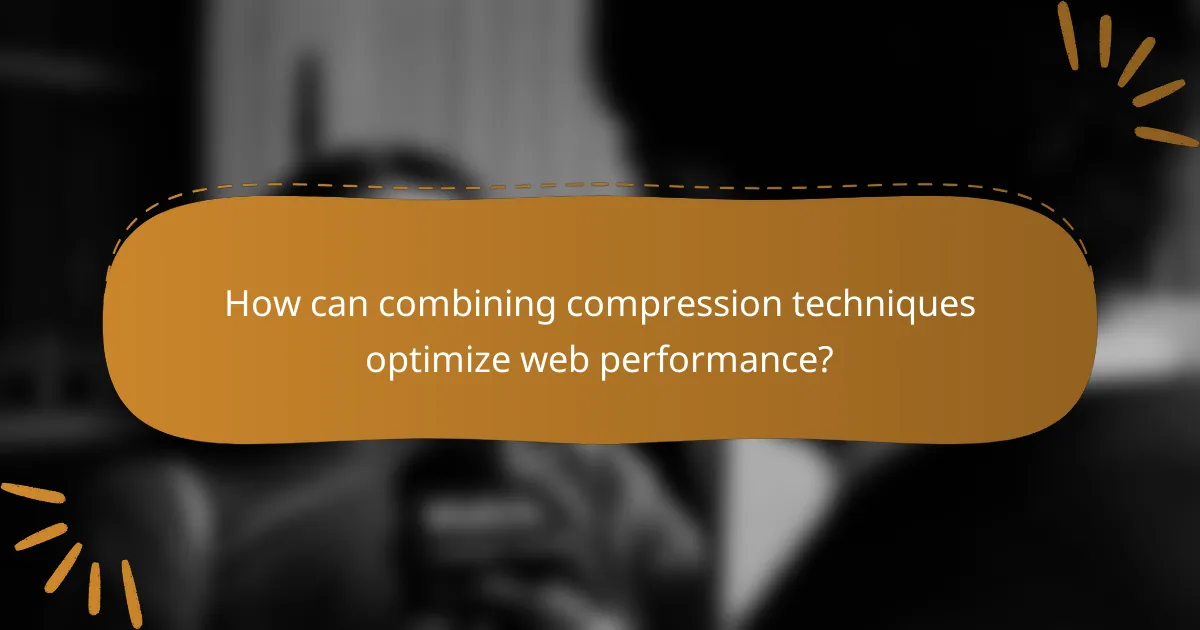
How can combining compression techniques optimize web performance?
Combining lossless and lossy compression techniques can significantly enhance web performance by reducing file sizes while maintaining acceptable quality. This dual approach allows for faster loading times and improved resource management, ultimately benefiting both users and website operators.
Improved user experience
A seamless user experience is crucial for retaining visitors. By utilizing combined compression techniques, websites can load faster, reducing the time users spend waiting for content to appear. This is particularly important on mobile devices where bandwidth may be limited.
For instance, images can be compressed using lossy techniques to decrease their size, while text files can be compressed losslessly to ensure no data is lost. This balance helps maintain visual quality while enhancing speed, leading to higher user satisfaction.
Better SEO rankings
Search engines prioritize fast-loading websites, making optimized compression techniques essential for improving SEO rankings. A site that loads quickly is more likely to rank higher in search results, attracting more organic traffic.
Implementing a combination of compression methods can lead to reduced page load times, which is a critical factor in Google’s ranking algorithm. Websites that achieve loading times in the low seconds or even sub-second range often see a positive impact on their search visibility.
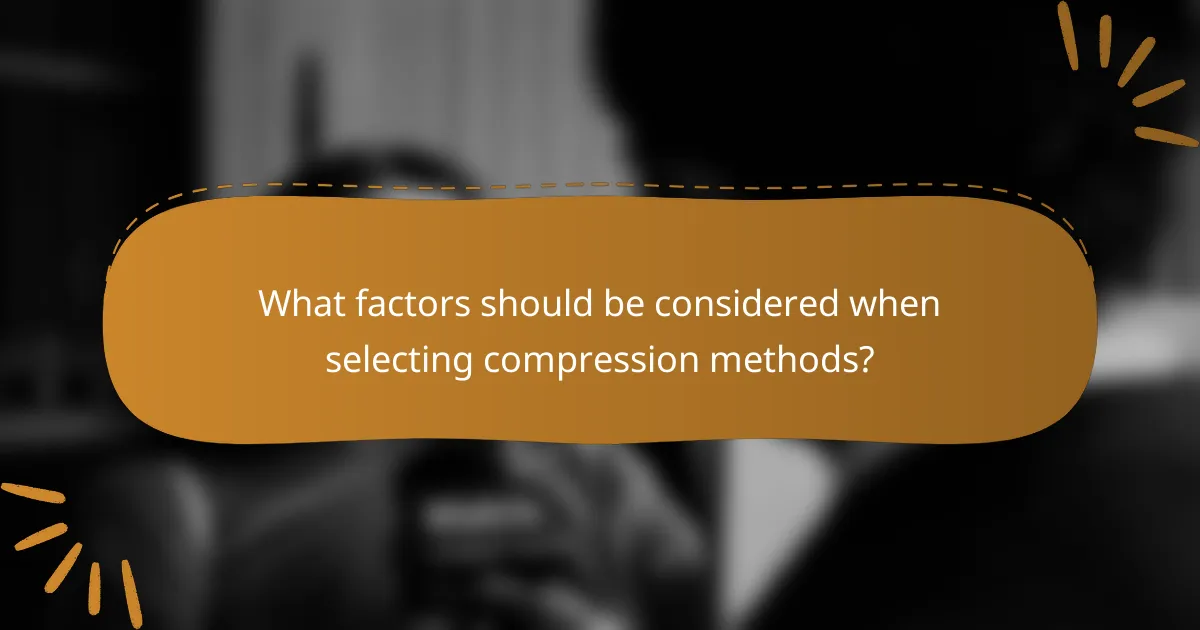
What factors should be considered when selecting compression methods?
When selecting compression methods, it’s essential to consider the balance between lossless and lossy techniques, as well as the performance gains each method offers. Factors such as the target audience, device types, content type, and quality requirements will significantly influence the choice of compression strategy.
Target audience and device types
The target audience and their device types play a crucial role in determining the appropriate compression method. For instance, users on mobile devices may benefit from lossy compression to reduce load times and data usage, while desktop users might prefer lossless methods for higher fidelity.
Understanding the demographics of your audience can guide the compression choice. If the majority of users access content via high-speed internet, you might opt for higher quality, lossless compression. Conversely, if many users are on slower connections, prioritize faster, lossy options.
Content type and quality requirements
The type of content being compressed greatly affects the compression method selected. For text-based content, lossless compression is often sufficient and preserves integrity, while images and videos may require lossy compression to achieve significant size reductions without noticeable quality loss.
Quality requirements are equally important. For professional photography or video production, lossless methods are preferred to maintain original quality. In contrast, for web graphics or streaming media, lossy compression can provide acceptable quality at a fraction of the file size, enhancing user experience.
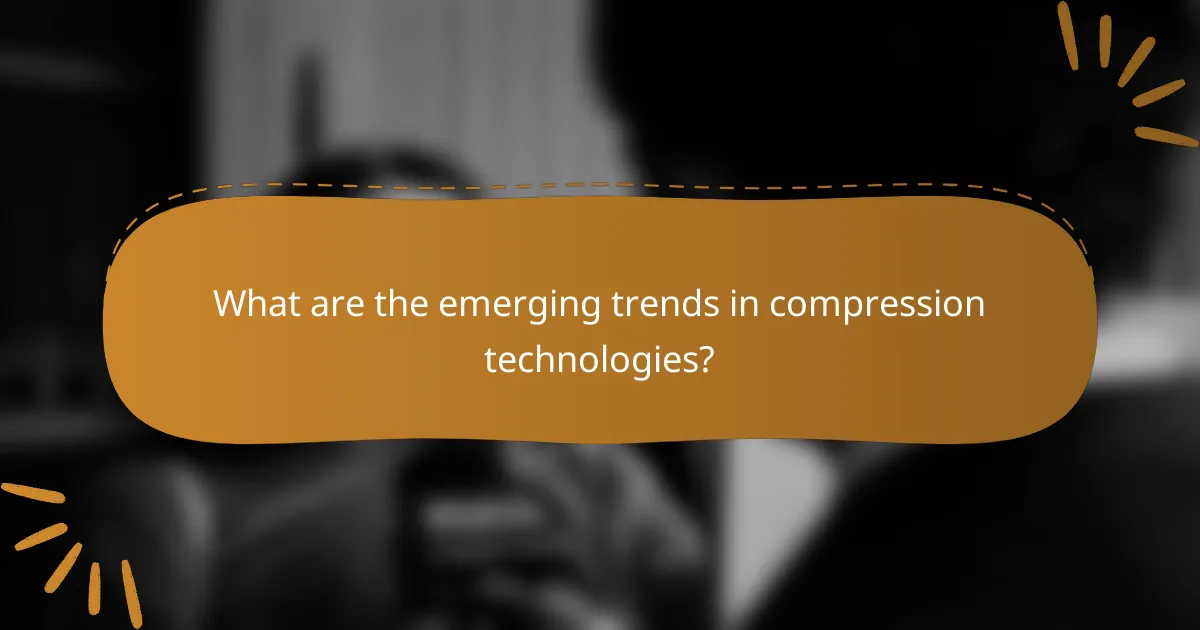
What are the emerging trends in compression technologies?
Emerging trends in compression technologies focus on enhancing efficiency and performance through innovative methods. These include the integration of artificial intelligence and real-time processing capabilities, which significantly improve data handling across various applications.
AI-driven compression solutions
AI-driven compression solutions leverage machine learning algorithms to optimize data reduction processes. By analyzing patterns in data, these systems can achieve higher compression ratios while maintaining quality, making them particularly useful for images and videos.
For instance, AI can adaptively choose the best compression method based on the content type, resulting in better performance compared to traditional techniques. This approach can lead to savings in storage costs and faster data transmission times.
Real-time compression for streaming
Real-time compression is crucial for streaming applications, where data must be processed and transmitted with minimal delay. Techniques such as adaptive bitrate streaming adjust the quality of the video based on the viewer’s bandwidth, ensuring a smooth experience.
Implementing efficient codecs like H.265 or AV1 can improve compression rates, allowing for high-quality streams even in low-bandwidth scenarios. It’s essential to balance compression levels with latency to avoid buffering, which can detract from user experience.
